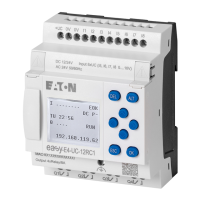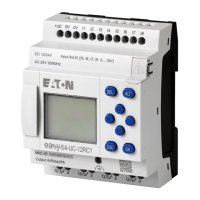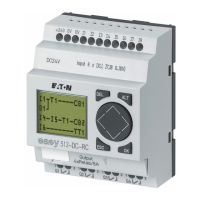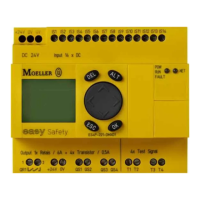10. easyE4 communication Connection to other devices
10.17 Modbus TCP
Amount Items
You can use the Amount Items field to define a contiguous range in order to accel-
erate communication, as only a single frame request will be needed for a large num-
ber of elements.
Depending on the specific function code, "element" may refer to various data formats.
The element will be of data type BIT in the case of the following function codes: FC1,
FC2, FC5, FC15. Meanwhile, it will be of data type WORD in the case of the following
function codes: FC3, FC4, FC6, FC16, FC23.
Operand class
The operand class limits the assignment of Modbus TCP server data to easyE4 base
device operands.
The Modbus TCP server's registers are automatically assigned to Modbus TCP
server module I/O points. Based on the selected operand class, they will be available
in the subregisters under the Assigned operands tab: bit inputs, bit outputs, analog
inputs, analog outputs, or diagnostic alarms. You can then assign them to easyE4
base device operands in the Assigned operands register.
FC
dec
Available operand classes
FC1
I, ID
FC2
I, ID
FC3
IA16, IA32
FC4
I, ID, IA16, IA32
FC5
Q
FC6
QA16, QA32
FC15
Q
FC16
QA16, QA32
FC23 read
IA16, IA32
FC23 write
QA16, QA32
Example: Function code FC4
Function code FC4, Read Input Registers, is available for a value assignment.
I can be selected as the assigned operand class. After this, the register with start
address 40 will be automatically assigned to a Modbus TCP server module input
register. The corresponding bits will then be available in a bitwise manner. In an addi-
tional step, you can go to the Assigned operands tab and assign the 16 bits in the
Modbus TCP server module input register to the easyE4 base device's input oper-
ands. This means, for example, that you can select the 1st bit and the 5th bits and the
15th bit and assign them to input operands I11, I12, and I13.
If you select ID as the operand class, the register with start address 40 will be auto-
matically assigned to a Modbus TCP server module input register as well. The cor-
responding bits will then be available in a bitwise manner too. In this case, however,
you will only be able to assign them to the easyE4 base device diagnostic alarms in a
bitwise manner under the Assigned operands tab.
easyE402/24 MN050009ENEaton.com
785

